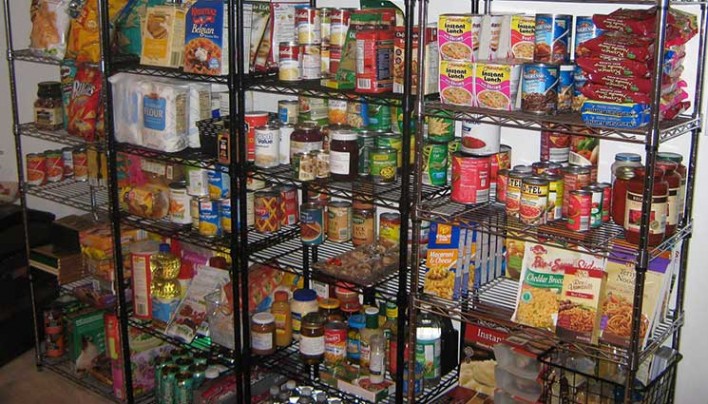Foods to Stock at Home and in Your Disaster Supplies Kit
Stocking and Storing Food and Water Safely
Even though it is unlikely that an emergency would cut off your food supply for two weeks, consider maintaining a supply in your home that will last that long. The easiest way to develop a two-week stockpile is to increase the amount of basic foods you normally keep on your shelves. Check expiration dates frequently and follow the practice of first-in, first-out.
RELATED : Lindsey Williams – Warning to prepare for an emergency. Stock up on food, water and supplies now!
Pack at least a three-day supply of nonperishable food and water in your Disaster Supplies Kit to be used incase you need to evacuate. Three days worth of supplies should be enough to get you to a location that has additional supplies. This may be outside the impacted area. You need to have these items packed and ready in case there is no time to gather food from the kitchen when disaster strikes. Include both compact, lightweight items like dehydrated foods, which are easy to carry if you must evacuate, and canned foods like fruit, juices, and vegetables that supply a source of water. Choose foods that require no refrigeration, preparation, or cooking. If you must heat food, pack a can of cooking fuel, such as used for camping. Do not pack gasoline, kerosene, or propane.
RELATED : The EPA Legally Controls All Water, Food Production and Private Property
Familiar foods can lift morale and help people feel secure in time of stress. Try to include foods that everyone will enjoy. Look for foods high in calories, protein, carbohydrates, vitamins, and minerals. Look for canned foods with high liquid content in case water is scarce.
Specifically, consider packing:
- Ready-to-eat canned meats, fruits, and vegetables.
• Canned juice, milk, and soup.
• High-energy foods, such as peanut butter, jelly, salt-free crackers, and energy bars.
• Trail mix (prepackaged or homemade).
• Comfort foods, such as hard candy, sweetened cereals, candy bars, and cookies.
• Instant coffee, tea bags.
• Compressed food bars. They store well, are lightweight, taste good, and are nutritious.
• Dried foods. They can be nutritious and satisfying, but may contain a lot of salt, which promotes thirst. If salt is a problem, used dried fruit, like raisins.
• Freeze-dried foods. They are tasty and lightweight, but will need water for reconstitution.
• Whole-grain cereals (oatmeal, granola, multi-grain).
• Instant meals. Cups of noodles or cups of soup are a good addition, although they need water for reconstitution and may contain a lot of salt.
• Snack-sized canned goods, which generally have pull-top lids or twist-open keys.
• Prepackaged beverages. Those in foil packets and foil-lined boxes are sealed and will keep for a long time if the seal is not broken.
• Foods for infants, elderly persons, or persons on special diets.
• Nonperishable foods for pets and other animals.
When selecting foods, keep in mind that:
- Salty foods are usually not a good choice because they will make you thirsty and drinking water may be in short supply.
• If your water supply is limited, you should avoid eating foods that are high in fat and protein, even if they are part of your emergency supply, because they require more water for the body to metabolize.
• Commercially dehydrated foods often require a lot of water for reconstitution and effort to prepare.
• Food packaged in glass bottles and jars is usually heavy and bulky, and the glass can easily break.
• Meal-sized canned foods are usually heavy and bulky, but they can be useful because they contain water.
• Whole grains, beans, and dried pasta require water and cooking time for preparation that could be difficult in a disaster situation.

If your electricity goes off and you lose refrigeration:
- First, use perishable food from the refrigerator.
• Then, use the food from the freezer. To minimize the number of times you open the freezer door, post a list of freezer contents on it. In a well-filled, well-insulated freezer, foods will usually still have ice crystals in their centers (meaning foods are safe to eat) for at least two days.
• Finally, begin to use nonperishable foods and staples.
RELATED : The Reality of SHTF: War, Water, Food and Population Effects
Storing Water
Having an ample supply of clean water is a top priority in an emergency. The following guidelines will help you ensure that members of your household have sufficient water in an emergency situation:
- Keep at least a three-day supply of water, that is, a minimum of three gallons per person. It is strongly recommended that you store more if possible. Each person should have one-half gallon per day for drinking and one-half gallon for cooking and sanitation. A normally active person needs to drink at least one-half gallon of water each day. Hot environments and intense physical activity can double that amount. Children, nursing mothers, and ill people will also need more. Be sure to include drinking and clean-up water for your pets. The amount needed will depend on their sizes and the conditions. Remember that pets often drink more water than usual when under stress.
• To prepare the safest and most reliable emergency supply of water, purchase commercially bottled water.
RELATED : Inflation? Only If You Look At Food, Water, Gas, Electricity And Everything Else
Keep bottled water in its original container and do not open it until you need to use it.
- Store bottled water in the original sealed container and observe the expiration or “use by” date.
- If you are preparing your own containers of water, follow the directions below for selecting, cleaning, and filling the containers with water:
• Purchase food-grade, water-storage containers from surplus or camping supplies stores to use for water storage. • If you chose to use your own storage containers, chose two-liter, plastic soda bottles—not plastic jugs or cardboard containers that have had milk or fruit juice in them. Milk protein and fruit sugars cannot be adequately removed from these containers and provide an environment for bacterial growth when water is stored in them.
• Do not use glass containers because they can break and are heavy.
• Do not use cardboard containers, because they can leak easily. These containers are not designed for long-term storage of liquids.
• If storing water in plastic soda bottles or food-grade, water-storage containers, follow these steps: - Thoroughly clean them with dishwashing soap and water, and rinse them completely so there is no residual soap.
• Sanitize them and their caps by adding a solution of 1 teaspoon of non-scented liquid household chlorine bleach to a quart of water. Swish the sanitizing solution in the containers and caps so that it touches all interior surfaces. After sanitizing the containers and caps, thoroughly rinse out the sanitizing solution with clean water. - To fill water containers:
- Fill them to the top with regular tap water. If the tap water has been commercially treated from a water utility with chlorine, you do not need to add anything else to the water to keep it clean. If the water you are using comes from a well or water source that is not treated with chlorine, add two drops of non-scented liquid household chlorine bleach to the water.
• Tightly close the containers using the original caps. Be careful not to contaminate the caps by touching the inside of them with your fingers.
• Place a date on the outside of the containers so that you know when you filled them. Store them in a cool, dark place. - Replace the water every six months if not using commercially bottled water
- Store your three-day supply in a handy place. You need to have water packed and ready in case there is no time to fill water bottles when disaster strikes.
RELATED : When Disaster Strikes: Prepare an emergency food supply
Survival MD (Best Post Collapse First Aid Survival Guide Ever)
Backyard Innovator (A Self Sustaining Source Of Fresh Meat,Vegetables And Clean Drinking Water)
Blackout USA (EMP survival and preparedness)
Conquering the coming collapse (Financial advice and preparedness )
Liberty Generator (Build and make your own energy source)
Backyard Liberty (Easy and cheap DIY Aquaponic system to grow your organic and living food bank)
Bullet Proof Home (A Prepper’s Guide in Safeguarding a Home )
Family Self Defense (Best Self Defense Strategies For You And Your Family)
Sold Out After Crisis (Best 37 Items To Hoard For A Long Term Crisis)
Survive The End Days (Biggest Cover Up Of Our President)
SOURCE : disastercenter.com



